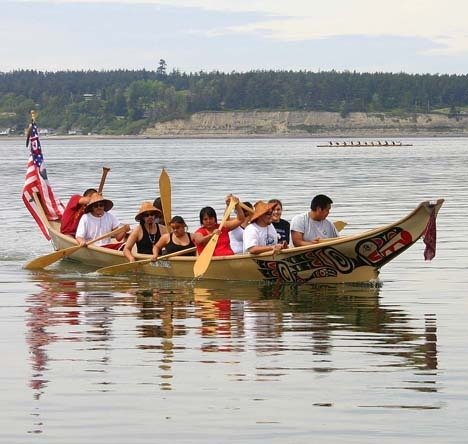The scene would be familiar to the ancestors of those in the canoe that pulls up to the shore below Jack Fairweather Park about noon on Friday: The cedar-decorated bow, the pullers wearing articles of clothing made from cedar, the ancient words of request for permission to land.
Canoes regularly plied the marine highway between the San Juan Islands and what is now Canada and mainland Washington state. Communities on the islands had different names then — p’kweekh-EEL-wuhlh, WH’LEHL-kluh, EH-leh-luhng, SMUH-yuh.
The tradition of canoe travel continued long after the settlement era changed the local landscape. The late Caroline “Toots” Mills, who was born in 1908, told the Seattle Post-Intelligencer in 2002, “Saanich, from Canada, used to come up in big long canoes; you could hear them singing on the water.” And the canoe culture was further bolstered in 1989 with the birth of the Canoe Journey.
Lummi’s ties to the San Juan Islands will be celebrated this weekend when representatives of the nation arrive for Friday Harbor’s Centennial Fourth of July celebration.
At noon, an 11-man Lummi canoe will arrive below the Coast Salish house posts — titled “Portals of Welcome” and carved by Musqueam artist Susan Point — at Friday Harbor Marina. The event is open to the public and will feature a welcoming ceremony officiated by Lummi Councilwoman Sherry Williams, Lummi Cultural Director James “Smitty” Hillaire and his wife, Lutie, and Friday Harbor Mayor David Jones.
Also present will be Centennial Advisory Committee member Doug Bison, a Native artist and great-grandson of Big Foot, leader of the Miniconjou Lakota Sioux, who was killed at Wounded Knee in 1890. Bison helped coordinate Lummi’s participation in the Fourth of July celebration.
The canoe’s arrival leads three days of Lummi participation in the town’s Fourth of July celebration. Lummi’s cultural presentations and participation are sanctioned by the town’s Centennial Advisory Committee and underwritten in part by the San Juan Island Community Foundation.
About 14 Lummi artists working in different media will exhibit their works Friday beginning at 9 a.m. in the Grange Hall. Lummi carver Charles Miller will do a carving demonstration in the breezeway between Golden Triangle and Pelindaba Downtown. The 12-foot cedar tree was donated by Joe Romano of Yacht Haven and delivered by Browne Lumber Co. Also demonstrating in the breezeway will be Lee and Isabelle Plaster, who are known for their cedar hats and other cedar work.
At the Grange, islanders can meet artists Shasta Little-Star Cano, Nanette Christianson, Candy Jefferson, Michelle Jefferson, Charmaine Lawrence, Misty Oldham, Michael Peters, Colby Schnackenberg, Janet Solomon, Maxine Stremler and Michael Thomas. Contemporary and traditional art expressions include carving, photography, prints, and weaving. Art will be available for purchase.
Friday at 6 p.m., the San Juan Historical Museum (405 Price St.) will host a historical presentation by James Hillaire, Al Scott Johnnie and Kathy Pierre. The presentation is free and open to the public, and refreshments will be served.
Saturday at 10:30 a.m., the Fourth of July Parade begins, featuring Hillaire as grand marshal, Lummi representatives in regalia, and a canoe. Art exhibit and sales resume frpm 1-6 p.m. in the Grange. Cano, a performer and singer, will present from 4-5:30 p.m. in the Grange.
Art exhibit and sales conclude Sunday, 9 a.m. to noon, in the Grange Hall.
The Lummi people believe San Juan Island to be their place of origin. The Point Elliot Treaty of 1855 created the Lummi reservation near Bellingham, but the Lummi and other original inhabitants of the island were forced to move beginning in 1872, when the territory dispute between the United States and Great Britain was settled and ownership was given to the U.S. by an arbitration panel.
Still, the Lummi Nation maintains cultural, historical and natural resources on the islands. In addition, Lummi owns Madrona Point, an ancestral village site on Orcas Island; and representatives serve on a board responsible for a cemetery at an ancient village site overlooking Speiden Channel.
Here is Mayor Jones’ proclamation that will be read Friday when the canoe arrives on Friday Harbor’s shore:
Whereas, the Town of Friday Harbor is committed to honoring the Coast Salish people and culture; and
Whereas, the Lummi Nation and other Coast Salish Tribes recognize that the Centennial for the Town of Friday Harbor is a significant cultural event; and
Whereas, the Lummi Nation is participating in the Centennial Celebration for the Town of Friday Harbor; and
Whereas, the Town of Friday Harbor supports a healthy, diverse community and is proud to host to the Lummi Nation as this year’s Grand Marshal in the 2009 Fourth of July Parade; and
Now, Therefore, I, David F. Jones, by virtue of the authority vested in me as Mayor of Friday Harbor do hereby proclaim this Third Day of July, Two Thousand and Nine, that
We Welcome the Lummi Nation
and encourage our citizens and visitors to participate in this weekend’s 4th of July festivities.
In Witness Whereof, I have hereunto set my hand and caused the Seal of the Town of Friday Harbor to be affixed this 3rd day of July 2009.
_______________________________
David F. Jones, Mayor



